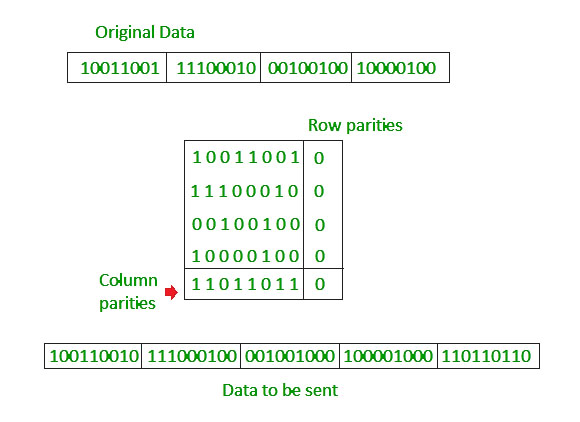

2D PARITY CHECK PROGRAM C CODE
The whole table is then sent to the receiver, which finds the syndrome for each row and each column.Hamming (7, 4) code: It is a linear error-correcting code that encodes four bits of data into seven bits, by adding three parity bits.Įxample: It is used in the Bell-Telephone laboratory, error-prone punch caret reader to detect the error and correct them. For each row and each column, 1 parity-check bit is calculated. In the following figure, the data to be sent, five 7-bit bytes, are put in separate rows. In this method, the data word is organized in a table (rows and columns).

This shows that the simple parity check, guaranteed to detect one single error, can also find any odd number of errors.Ī better approach is the two-dimensional parity check. Three bits-a3, a2, and a1-are changed by errors. The errors cancel each other out and give the syndrome a value of O.ĥ. The simple parity-check decoder cannot detect an even number of errors. Note that here the data word is wrongly created due to the syndrome value. The data word 0011 is created at the receiver. An error changes r0 and a second error changes a3. Note that although none of the data word bits are corrupted, no data word is created because the code is not sophisticated enough to show the position of the corrupted bit.Ĥ. You could sum them and verify if the sum is even: import numpy as np a np.array(8, 2, 10, 3, 12, 1, 5, 6) result (a.sum(1). In this article, you will learn and get code to implement two dimensional ( 2D ) array in C++. No error occurs the received code word is 10111. The code word created from this data word is 10111, which is sent to the receiver. The data word is not created.įor example, the sender sends the data word 1011. If the syndrome is 0, there is no error in the received code word, the data portion of the received code word is accepted as the data word, if the syndrome is 1, the data portion of the received code word is discarded. The syndrome is passed to the decision logic analyzer. The syndrome is 0 when the number of 1s in the received code word is even otherwise, it is 1. 2D parity is better at catching errors, but requires too many check bits added to a.
2D PARITY CHECK PROGRAM C FULL
The result, which is called the syndrome, is just 1 bit. A parity check matrix of a 2D convolutional code C is a full row rank matrix H ( z1, z2 ) E R ( n - k ) xn such that c ( 21, 22 ) E C if and only if H. Error Detection Codes Parity Check 1 By W.I.D.Perera(Esha) Vavuniya.
2D PARITY CHECK PROGRAM C GENERATOR
The checker at the receiver does the same thing as the generator in the sender with one exception: The addition is done over all 5 bits. The sender sends the code word which may be corrupted during transmission.


In other words, If the number of 1s is even, the result is 0 if the number of 1s is odd, the result is 1.In both cases, the total number of 1s in the code word is even. This is normally done by adding the 4 bits of the data word (modulo-2). The source then transmits this data via a link, and bits are checked and verified at the destination. A parity bit is appended to the original data bits to create an even or odd bit number the number of bits with value one. The parity bit that is added makes the number of 1s in the code word even. Parity Check: A parity check is the process that ensures accurate data transmission between nodes during communication. The data word bits and the parity bit create the 5-bit code word. To design a code that can correct d single bit errors, a minimum distance of 2d + 1 is. codes, speci cally single parity check (SPC) component codes which have the. The encoder uses a generator that takes a copy of a 4-bit data word (a0, a1, a2 and a3) and generates a parity bit r0. The parity bit is computed as the exclusive-OR (even parity) or. The two-dimensional code consists of a data block, parity checks on the rows. The following figure shows possible structure of an encoder (at the sender) and a decoder (at the receiver). The minimum Hamming distance for this category is dmin =2, which means that the code is a single-bit error-detecting code and it cannot correct any error. (1 point for row parity bits and 1 point for column parity bits) The below table shows the filled in parity bit (in. Although some implementations specify an odd number of 1s. The C++ program is successfully compiled and. The extra bit, called the parity bit, is selected to make the total number of 1s in the code word even. An apparatus for and a method of providing error correction in a random access memory (RAM) using two dimensional parity checking. In this code, a k-bit data word is changed to an n-bit code word where n = k + 1. The simple parity-check code is the most familiar error-detecting code.


 0 kommentar(er)
0 kommentar(er)
